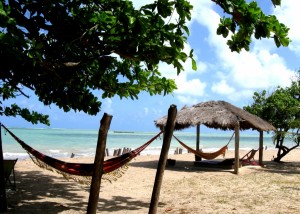
Photo © Michael Sommers.
Until fairly recently, deserted beaches, virgin forests, and undiscovered historical small towns used to be a dime a dozen in Brazil. However, last year foreign travel to Brazil hit a record high. Meanwhile Brazilians themselves (those able to resist overnight shopping spree packages to Miami) are traveling throughout their country more than ever before. Add to this the rapid spread of urbanization and the frantic pace of infrastructure development, and it’s become more of a Challenge to Get Off the Beaten Track in Brazil. And yet, it can be done.Here is a winning list of Top 5 Getaways from around the country; no matter which one you escape to, it’s a cinch you won’t be running into any folks from back home:
It’s amazing to think that at equidistance between South America’s two largest metropolises – Rio and São Paulo – one could stumble onto a seemingly forgotten colonial town nestled in the lush Serra da Bocaina mountain range. A major hub during São Paulo’s coffee boom, Bananal’s elegant squares and solares (mansions) are still intact as are the surrounding plantations built by the region’s coffee barons (some of which have been converted into guesthouses). Nature lovers can hike through the Parque Nacional da Serra da Bocaina , whose 250,000 acres of virgin Atlantic forest are brimming with wild orchids, hydrangeas, and waterfalls. If you’re feeling very intrepid, venture along the Trilha do Ouro, a former gold trail that winds over the hills to the coast; lasting 3 days, the trek includes lodgings and home cooked fare prepared in simple local homes.
It’s not as if the first capital of the Central-West state of Goiás doesn’t receive any tourists. During holidays, it gets its fair share from the current capital of Goiânia. What’s astounding, however, is that the rest of Brazil – and the world – haven’t caught on to the fact that this UNESCO World Heritage Site is quite simply one of the most charming and best preserved colonial towns in Brazil. Founded in 1726, Goiás began life as a rugged gold mining town before becoming a gracious state capital (a title it held until 1937). Today, it boasts all best elements of small town life in Brazil – from its languorous atmosphere and friendly locals to some of the most succulent home-cooking you’ll ever encounter – along with the natural attractions of the surrounding Serra Dourada, a mountain range carpeted in Cerrado vegetation.
Although the state of Bahia has one of the longest – and most beautiful – coastlines in Brazil, it’s also one of the most rapidly developing. Although it’s not that far from the hipster haven of Trancoso, Corumbau remains one of the most unspoiled beaches in Bahia as well as one of the most alluring. Its jade green waters are sheltered by coral reefs – a snorkeler’s dream – and its endless powder sand beaches are shaded by palms and almond trees. Getting here is a bit of a trip; there’s no bus service and driving takes forever (the easiest access is by boat). Then again, the tricky logistics provide you with a great excuse not to leave.
Milagre is Portuguese for “miracle”; in São Miguel’s case, the miracle stems from the fact that the major highway that runs north from Alagoas’ capital of Maceió to Pernambuco’s capital of Recife takes an inland detour in northern Alagoas. For this reason, the beaches surrounding this colonial fishing village are not only some of the most beautiful in Brazil, but also the most secluded. Surrounded by thick palm forests (água de coco is cheaper and more abundant than water in these parts), the beaches along the so-called Rota Ecológica (Ecological Route) are stunners, and their reef protected waters are flooded with a carnival of colorful fish. While São Miguel remains untrampled by tourism, a handful of charming and sophisticated pousadas (many run by gringos) makes this an ideal destination for a getaway with style.
The hottest eco-spot along the Amazon’s Rio Solimões is without a doubt the Mamirauá Reserve. Comprising the largest protected area of várzea (seasonally flooded Amazonian forest) in Brazil, Mamirauá combines conservation and research with the creation of sustainable employment for locals who work as guides and forest patrollers. It’s also one of the best places in the Amazon to see wildlife including pink dolphins, sloths, and the rare scarlet-faced uakari monkey. The reserve is a 90-minute boat ride from Tefé, the last outpost of civilization on the river. Although simple accommodation is available in Tefé, the ideal solution is to stay in the reserve itself at the Pousada Uacari, a floating jungle lodge.